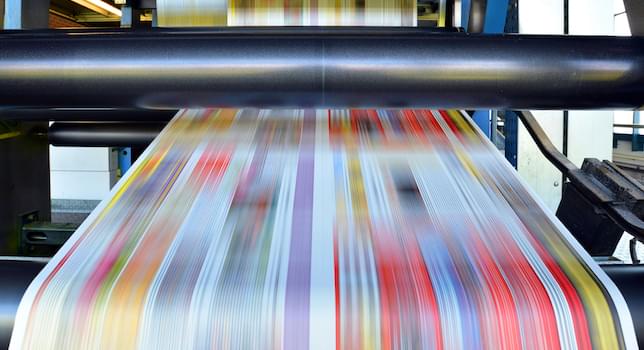
New printing press development takes multiple years and involves significant R&D investment. Therefore, it is important for printing press OEMs (and their supply chain partners) to align their business strategies – including product development investments and strategic partnership formation – with the most promising areas for future business.
This report considers the underlying drivers of print run length trends, their impact on print applications, and relevant print technology developments in both digital and analogue printing, aimed at improving the shorter-run performance and productivity of analogue printing and extending the competitive run length window for digital print.
Our exclusive content
This report is based on extensive primary and secondary research. Primary research consisted of targeted interviews with printing material suppliers, printers and experts drawn from key markets. This was supported by secondary research in the form of extensive literature analysis of published data, official government statistics, domestic and international trade organisation data, company websites, industry reports, trade press articles, presentations, and attendance at trade events.
About the author
Paul Ewing has over 20 years’ experience in the digital printing industry with ICI, Zeneca, Avecia and Fujifilm. He was VP of R&D and Business Strategy for Fujifilm Imaging Colorants, the speciality chemical arm of Fujifilm’s inkjet printing business. He has authored and co-authored several reports for Smithers, including The Future of Digital vs Offset Printing to 2024, and The Future of Digital Print: Long-Term Strategic Forecasts to 2029.
This report considers the underlying drivers of print run length trends, their impact on print applications, and relevant print technology developments in both digital and analogue printing, aimed at improving the shorter-run performance and productivity of analogue printing and extending the competitive run length window for digital print.
Our exclusive content
- The print business system encompasses many steps; as the number of lower run length jobs has grown, so the total number of distinct jobs has increased significantly
- In very general terms, analogue printing is more cost effective at longer run lengths and digital printing is more cost effective at short runs
- Understanding the relationship between cost per print and run length is critical in selecting the most cost-effective process.
- Key drivers impacting print run lengths include the changing face of retail and the shift to online and mobile channels across media and advertising
- The cost of producing short runs has fallen as digital presses have become more productive and consumables costs are reducing
- Changes in behaviour during the COVID-19 pandemic will tend to accelerate the demand for shorter runs
- Long-run print will grow in developing economies – especially in packaging and label applications
- Print production technologies are increasingly automated and capable of operating very efficiently across all run lengths
- There are increasing pressures on supply chains to improve sustainability and to operate with greater flexibility and responsiveness
- Demand for print run lengths is affected by many factors including sustainability, return on investment and supply chain efficiencies
- Printers
- Printing machinery and equipment suppliers
- Print end users
- Industry consultants and analysts.
This report is based on extensive primary and secondary research. Primary research consisted of targeted interviews with printing material suppliers, printers and experts drawn from key markets. This was supported by secondary research in the form of extensive literature analysis of published data, official government statistics, domestic and international trade organisation data, company websites, industry reports, trade press articles, presentations, and attendance at trade events.
About the author
Paul Ewing has over 20 years’ experience in the digital printing industry with ICI, Zeneca, Avecia and Fujifilm. He was VP of R&D and Business Strategy for Fujifilm Imaging Colorants, the speciality chemical arm of Fujifilm’s inkjet printing business. He has authored and co-authored several reports for Smithers, including The Future of Digital vs Offset Printing to 2024, and The Future of Digital Print: Long-Term Strategic Forecasts to 2029.
Name Impact of Changing Run Lengths on the Printing Market
Date 9/10/2021
Price $6500.00
